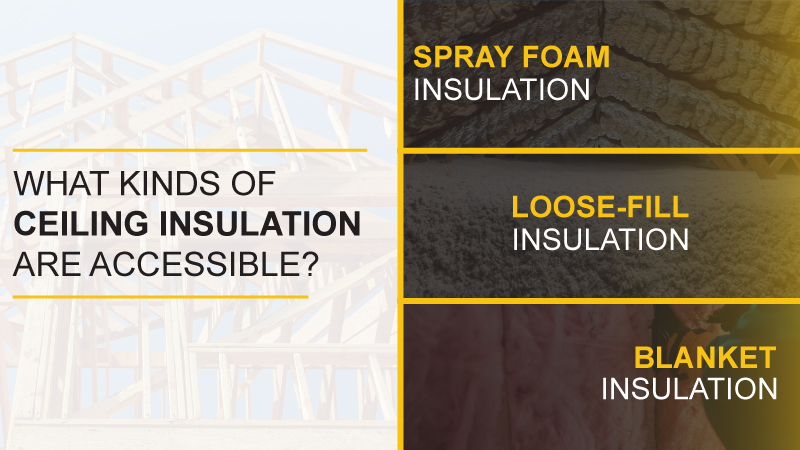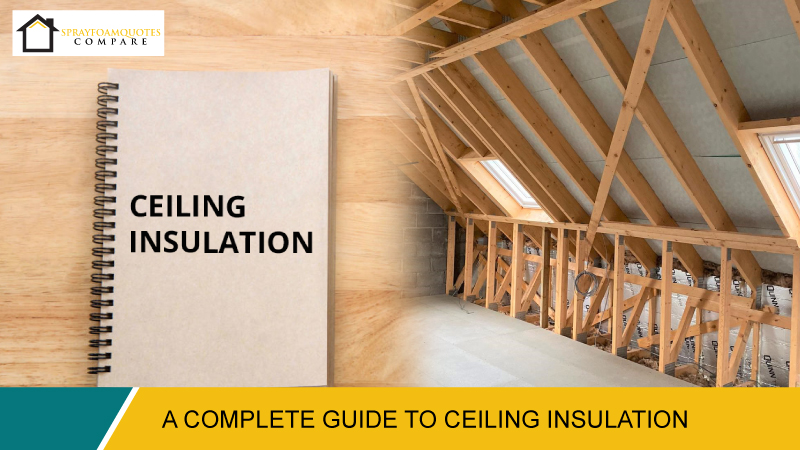Ceiling Insulation
Ceiling insulation refers to the material that is installed in the space between the ceiling and the top floor of a building. The purpose of ceiling insulation is to reduce heat transfer through the ceiling and improve the energy efficiency of a building. This helps to keep the interior of a building warm in the winter and cool in the summer, while also reducing energy costs. Common types of ceiling insulation include fiberglass, cellulose, and spray foam. The type of insulation used will depend on the specific needs of the building and the desired level of insulation.
Around 40% of the heat in a home can flee through an un-insulated roof or ceiling. This is a substantial amount of heat loss that can be easily prevented with better insulation.
Your home’s ceiling is the best place to start if you are trying to insulate your home or undertaking this task for the first time. It is seldom critical to understand how to insulate a ceiling all by yourself or hire a professional for the purpose.
Insulation in the ceiling that has been appropriately installed has two optimistic consequences. When it is cold outside, it first establishes a barrier to stop heat from soaring out of your house. Secondarily, during the warmer months, it prevents the sun’s rays from entering your home.
This enables your house to maintain the ideal temperature you require while saving you money on super-expensive cooling and heating costs. In this manual, you can get to learn about different kinds of insulation, how to insulate the ceiling from the inside, and the potential benefits of ceiling insulation.
Types of Insulation
You can employ a variety of insulation forms in your ceiling. Spray foam and glass wool are the most widely used materials. Both materials share qualities like being environmentally friendly, non-toxic, water-proof, and non-allergenic. These are both excellent options for your ceiling because they are both self-supporting and have a long lifespan.
Due to its relatively low price, fibreglass insulation is the most widely used type of insulation in England. Because of its exceptional quality of insulation and sustainability, Earth wool is the glass wool insulation of choice for us. It is non-combustible, recyclable, and soluble, to put it briefly.
If you want superior noise cancellation and noise absorption, polyester insulation is the best option. While polyester offers many of the same advantages as fibreglass, it is denser and devoid of breathable fibres.
The R-value of insulating materials is used to determine their effectiveness. Based on where you live in the country, different minimum R-value standards apply. The minimum R-value requisite for insulation in the central plateau is R 3.3. Before installation, make sure your insulation satisfies the minimum requirements.
It is important to consult the experts if you are uncertain whether the insulation in your home is sufficient or the exact ceiling insulation cost. Making the best choices for your home’s health and energy efficiency involves investing in insulation, so professional advice can assist you.
We provide free home evaluations, which entail a member of our staff visiting your residence to evaluate your insulation and provide you with knowledgeable guidance. Our qualified team can assist you in identifying the perfect option for your property kudos to their extensive knowledge of regulatory frameworks, product efficacy, and cost.
Contact us right away at Spray Foam Quotes Compare to schedule your free home inspection or compare different quotes.
What is the Best Way to Insulate a Ceiling from the Inside?
You can eschew heat losses and an absurdly high energy bill by shielding your ceiling from the inside. Warm air rises, but with ceiling insulation particularly here in the UK, you can maintain the warmth inside while also greatly reducing noise. It is a simple and inexpensive way to improve your home’s energy efficiency. After the rafter mates have been installed, you can start installing insulation.
Spray foam insulation is the most efficient and cost effective method to insulate a ceiling from the inside. Trying to install your own insulation is certainly achievable with certain kinds of insulation materials and you can save money by not employing a contractor.
The installation of fibreglass or mineral wool insulation is a simple do-it-yourself project. Other types of insulation, such as spray foam insulation, necessitate the use of a professional.
Similarly, as your basement will be cold in the winter, you’ll need to insulate any ductwork and hot-water pipes below the ceiling, weather-strip the basement door, and seal it with a thick layer of spray foam around the water-heater tank. It is recommended to opt for basement ceiling insulation during the winter.
Again many homeowners in England have conservatory extensions installed on their properties; they are a good home addition, but it is critical to comprehend the conservatory ceiling insulation implications. Conservatories, which typically have a lot of window space, can cause a lot of problems for your home if they are not insulated, especially during cold winter nights.
Your fantastic new addition may simply become an uncomfortable place to be, so in order to avoid a squandered conservatory, you can effectively insulate it with spray foam and ensure it lives up to its full potential.
What kinds of Ceiling Insulation are accessible?

When choosing insulation for your home, you can choose from a variety of insulation types, each of which has advantages and disadvantages. It is crucial to choose the right insulation category for your ceiling because it will determine the impact it has on your property.
The three primary types of ceiling insulation are as follows:
1. Spray Foam Insulation
2. Loose-Fill Insulation
3. Blanket Insulation
1. Spray Foam Insulation
Out of the three insulation types mentioned above, spray foam is a buyer’s most preferred choice and likely the best insulator. Your ceiling’s insulation barrier is easily created by spraying this water-resistant and soft-foam insulation into the joists and rim joists.
While there are numerous varieties of spray foam, we employ Icynene spray foam insulation because it’s made by one of the industry’s main suppliers. In its closed-cell form, spray foam, the industry’s best thermal insulator, can significantly lessen the amount of energy lost through your ceilings.
Nothing is more unpleasant than a damp ceiling that rots and affects the configuration of your property, so ceiling also needs to fight against moisture growth. Fortunately, spray foam’s open-cell structure can fight against the growth of mould and moisture while enabling the joists to breathe during installation, ultimately preventing the accumulation of condensation.
Notably, due to its longevity, spray foam might offer one of the ceiling insulation solutions that will last the longest. It is possible to have a long-lasting and realistic solution for your ceiling because the insulating material does not sag or settle over time.
2. Loose Fill Insulation
Insulation made of loose fill is a substitute to spray foam. Numerous materials, including cellulose which is created from recyclable materials, fibreglass, mineral wool, and others, can be used to create this type of insulation.
Loose-fill insulation can be efficiently blown into tight spaces, joists, and cavities using a blowing machine. Because of its dimensions and blown-in application, it has the ability to cover the majority of areas with insulation.
It is crucial to remember that if loose-fill ceiling insulation gets wet, it may be susceptible to moisture and mould growth. There are ways to deal with this issue, like installing soffit vents, but doing so will only increase project costs and lengthen project timelines.
The effectiveness of the thermal insulation in your ceiling will also be diminished as blown-in cellulose or fibreglass sags, changes, and develops unwanted holes and gaps.
3. Blanket Insulation
As an alternative to loose-fill insulation, blanket insulation is typically provided in rolls or batts which can be efficiently cut, fitted, and placed into joists. Usually made of fibreglass, mineral wool, or natural fibres, blanket insulation has the advantage of being easy to apply.
However, because it might not fit easily into all zones of your ceiling, particularly harder-to-reach areas, it is one of the weaker ceiling insulations available. Therefore, gaps will reduce the insulation’s ability to insulate your ceiling
What are the Potential Benefits of Ceiling Insulation?
Ceiling insulation has numerous advantages for both residential and commercial properties, and it is suitable for all kinds of ceilings. You are likely to experience the following benefits by having your ceiling insulated
• Energy Saving
Ceiling insulation provides energy efficiency gains all year long. Throughout the summer and winter months, your property will be a more comfortable place to live or strive. All kinds of insulation spray foam, cellulose, batt and far more have a specific level of thermal resistance, helping to effectively control the internal temperature of a property. Cost of spray foam insulation, on the other hand, has a higher insulating level, and you will most likely get better and therefore more energy-effective performance if you apply foam insulation to the ceiling.
• Great Acoustic Insulation
Certain sorts of insulation can benefit you to soundproof your ceiling. This can be incredibly helpful if you have loud noises from piping, a space in your loft space that you want to tamp down the sound of, or noise coming from a variety of other purposes. Icynene insulation products are well-known for their sound-absorbing properties, which can make your office or home a more comfortable place to live.
• Cordial to Environment
Because 25% of energy loss happens through the roof, having installed any insulation in the ceiling will reduce your reliance on both the heating and cooling expenses of the property. As a result, ceiling insulation will probably decrease your carbon emissions production and carbon footprint year after year. Some kinds of insulation, such as spray foam as well as blown-in cellulose, are also made from recycled materials such as newspapers, further enhancing insulation’s environmental friendliness.
Conclusion
When moisture accumulates in the ceilings of buildings, it can have devastating results such as decomposing timber, mould formation, an unsanitary living environment, and more. As a result, when choosing ceiling insulation, we highly urge you to look for a solution that prevents condensation build-up in order to provide a more pleasant and relaxed living environment. If you are keen to know more about ceiling insulation, contact one of our insulation experts from Spray Foam Insulation Quotes Compare today for a free consultation or to obtain an instant bespoke Quote.


